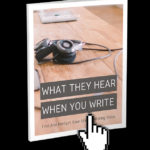Honestly, most people don’t know how I make a living. And, when I say “most people” I mean my husband, my mom, and pretty much everyone outside of this online narnia world that I’ve found myself.
My husband, when I started working with Ramit Sethi, told someone I teach people how to make effective investments in the stock market. If you asked him today, I’m pretty sure he wouldn’t have a better answer except he’s learned I work on “launches.” (Maybe he thinks I’m resurrecting NASA?)
I’ve had people ask me if I do copyrights — as in, can I help their buddy protect his songwriting?
Heck, some people IN the industry think that copywriters are the people that sprinkle magic fairy dust on your websites to make more sales. (actually, as I’m typing that, it may be one of the more accurate descriptions.)
Why is copy so mysterious?
When we were in high school (or even younger), we got the speech about why math was important.
You need to make sure you have enough money for your groceries with tax. You need to calculate how much you owe to the shared restaurant bill plus tip. You need to figure out if your couch will fit in that one corner of your living room — and how to carry it so it fits through the door.
No one ever really questions the need to learn English. We all need to read and write daily and most of us have to communicate ideas effectively to other human beings.
But what about copywriting?
The truth is, learning copy skills today can be as crucial as understanding percentages and basic geometry. Daniel Pink makes the case in his book “To Sell Is Human” that we’re all salespeople, regardless of our job title — we need to sell our bosses on our ideas, our spouses on our movie preferences, and our kids on the delicious allure of broccoli.
I’d take it a step further and say that we all write sales copy. A copywriter can attest, our skills come in handy in a variety of obscure and unpredictable places. I’ve more than once swapped stories with my colleagues about helping a friend get a date via text or Tinder chat.
I bet a copywriter can tell you the answer to these questions:
- Why won’t anyone “like” my facebook status?
- Why won’t that douche at work just respond to my email?
- How can I get out of the friend zone?
Copywriting in business is about more than writing effective sales pages and e-mails. Good copy can permeate everything you do, from media outreach to customer support. Copywriting at its core can be described very simply: using words to get someone to take an action. That person could be a customer, but it could also be an investor, a partner, or a reporter.
A good copywriter is one that can help you in all of these areas. I have clients that routinely send me personal emails to look over, customer retention copy, or even sponsorship proposals. If you took a look at your business, you could probably name many areas where a one more “Yes” could’ve made a huge impact.
Here’s a few copywriting principles you can apply to ALL of your communication:
Copy tricks you can use every day
1. It’s about them, not you
Have you ever had someone tell you about the “dream they had last night?” Excruciating, right!? They are usually visibly emotional and committed to the story but you’re just waiting for it to end. Emails can give you the same feeling.
I have a few post-it’s taped to the wall behind my computer. This is one of them:

I have to remind myself of this because I LOVE TALKING ABOUT ME. We all do. Proof: How many times have you been listening to a friend tell a story and suddenly your own mind is filled with stories about you? You stop listening and wait for them to finish talking so you can say, “Yeah, me too! me too… but mine is better”
The same thing happens when we write. But, while personal stories and anecdotes can make what you’re saying more concrete and relatable, at the end of the day, no piece of communication should leave the reader thinking, “What was the point of that?”
Each sentence, even if it’s a personal story, should communicate value to the reader. This is true for email, text messages, and just general conversation.
In one of my first client pitches, I made this awful mistake. I really resonated with her messaging, so much so that I have a tattoo that could be the tagline for her site. Oh no you didn’t! Yup. In our first email, I shared with her my tattoo. I thought it would prove that we were meant to be. Needless to say, we didn’t end up working together.
There’s a difference between what we want to write and what people want to read. Reread your communication as if you’re the reader and cut anything that doesn’t add value to their lives in some way.
NOTE: This works with spouses, too. A cornerstone of effective relationships is seeing the situation from their perspective.
2. Meet them where they are
This is directly related to point #1. Frankly, people have a thousand things they’re thinking about every day. This means even if they like you, they’re only devoting a small amount of time and energy to what you have to say.
How do you read your email? In between projects, on the train, or during lunch. Texts are even worse. So when someone sends you something, you glance over it quickly. If it seems like too much to digest, you come back to it later — or plan to and it gets buried.
Keep this in mind when you’re communicating with someone. They are walking down a busy street, waiting in line for coffee, or holding their phone in one hand while watching an enthralling reality TV show.
Journalists take this idea to heart because they know that reading a newspaper is the same way. They focus a huge amount of time on two key parts of an article: the headline and the “lede.”
The headline can be translated to your subject line. Don’t write a mysterious or overwhelming subject line.
Bad Subjects:
- “Hey you :-)”
- “Just catching up”
- “Huge favor to ask”
Good Subjects:
- “Can you take a look at this? (2 min)”
- “Movie tonight at 7?”
- “Love what you’re doing with X”
Double points for the last one because people love a good ego stroke, no matter what they’re in the middle of.
The “lede” of your story is your first paragraph. The goal of the lede is to get the reader to read the rest of the email. Tell them what you’re going to tell them. In journalism, the lede contains the who, what, where, when, and why of the story. Your email should do the same.
Check out a typical email I would get when I worked in a corporate environment:
Hey Abbey,
I know you’re good at writing… Last week Bill asked me to draft a proposal on XYZ. I was happy to do it even though this week has been crazy for me with Project A and Project B (I know you feel me there haha). I’ve been struggling all week and I think I finally got a decent draft. The beginning is alright but then it gets a little confusing. But, maybe it’s ok and I’ve just looked at it too much. Anyway… [Continues for 3 paragraphs before I know exactly why I’m getting this]
Ahhhh… get to the point! Here’s how I would draft the same email:
Hey Abbey,
Quick favor. Could you look at this proposal and give me your thoughts? I’m especially worried about paragraph 4 and I’d love your expert input.
…Then you can go into more details about what the proposal is, why you’re writing it, etc. I know exactly what you’re asking and can skim the details if I need to.
Which leads to…
3. Don’t distract them from the purpose of the copy
Let’s take another look at the above emails. Part of why the first example fails is there is just too much extraneous information. I don’t need to know that Bill asked you to write the proposal and I certainly don’t need to know about the other, unrelated tasks on your plate this week.
The main problem here is that humans by nature don’t think linearly. Our ideas float around and bump into each other which is how we’re able to innovate and come up with creative strategies to solve problems. When writing we have to keep that in check. Each thought leads to another and if we’re not careful, we write down our stream of consciousness as it flows and it becomes a tangled mess.
The way you can catch that in the example above is the use of the word “anyway.” If you catch yourself using “anyway” or “back to what I was saying” or “point is,” you’ve gone terribly wrong. Those tangents are an opportunity for the reader to close your email without ever getting to what you need. You can include stories and niceties without getting off track. (In the second email, can you spot how I complimented the reader using just one word?)
And my favorite copy trick…
My favorite copy trick of all I use all the time (actually we all do it naturally, but you can maximize its effect). It’s called language mirroring. It’s too much to include in this post so I put together a guide here. Check it out and let me know what you think. You’ll be surprised at how frequently it comes in handy in everyday life. Grab it here.


Leave a Reply